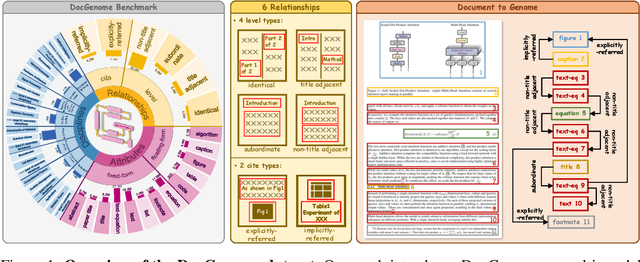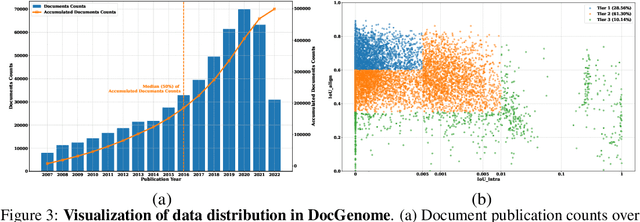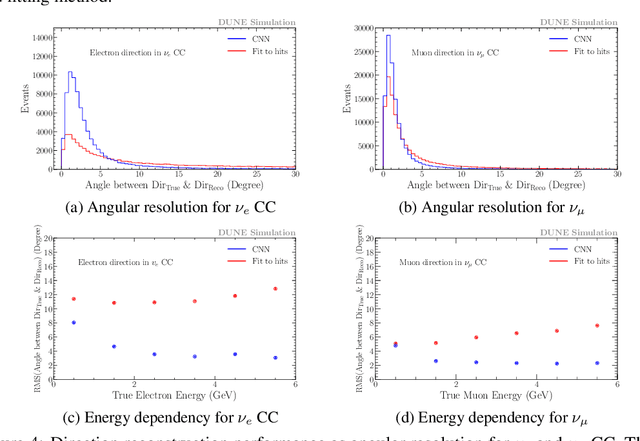Wenjie Wu
Particle Hit Clustering and Identification Using Point Set Transformers in Liquid Argon Time Projection Chambers
Apr 11, 2025Abstract:Liquid argon time projection chambers are often used in neutrino physics and dark-matter searches because of their high spatial resolution. The images generated by these detectors are extremely sparse, as the energy values detected by most of the detector are equal to 0, meaning that despite their high resolution, most of the detector is unused in a particular interaction. Instead of representing all of the empty detections, the interaction is usually stored as a sparse matrix, a list of detection locations paired with their energy values. Traditional machine learning methods that have been applied to particle reconstruction such as convolutional neural networks (CNNs), however, cannot operate over data stored in this way and therefore must have the matrix fully instantiated as a dense matrix. Operating on dense matrices requires a lot of memory and computation time, in contrast to directly operating on the sparse matrix. We propose a machine learning model using a point set neural network that operates over a sparse matrix, greatly improving both processing speed and accuracy over methods that instantiate the dense matrix, as well as over other methods that operate over sparse matrices. Compared to competing state-of-the-art methods, our method improves classification performance by 14%, segmentation performance by more than 22%, while taking 80% less time and using 66% less memory. Compared to state-of-the-art CNN methods, our method improves classification performance by more than 86%, segmentation performance by more than 71%, while reducing runtime by 91% and reducing memory usage by 61%.
Benchmarking Reasoning Robustness in Large Language Models
Mar 06, 2025Abstract:Despite the recent success of large language models (LLMs) in reasoning such as DeepSeek, we for the first time identify a key dilemma in reasoning robustness and generalization: significant performance degradation on novel or incomplete data, suggesting a reliance on memorized patterns rather than systematic reasoning. Our closer examination reveals four key unique limitations underlying this issue:(1) Positional bias--models favor earlier queries in multi-query inputs but answering the wrong one in the latter (e.g., GPT-4o's accuracy drops from 75.8 percent to 72.8 percent); (2) Instruction sensitivity--performance declines by 5.0 to 7.5 percent in the Qwen2.5 Series and by 5.0 percent in DeepSeek-V3 with auxiliary guidance; (3) Numerical fragility--value substitution sharply reduces accuracy (e.g., GPT-4o drops from 97.5 percent to 82.5 percent, GPT-o1-mini drops from 97.5 percent to 92.5 percent); and (4) Memory dependence--models resort to guesswork when missing critical data. These findings further highlight the reliance on heuristic recall over rigorous logical inference, demonstrating challenges in reasoning robustness. To comprehensively investigate these robustness challenges, this paper introduces a novel benchmark, termed as Math-RoB, that exploits hallucinations triggered by missing information to expose reasoning gaps. This is achieved by an instruction-based approach to generate diverse datasets that closely resemble training distributions, facilitating a holistic robustness assessment and advancing the development of more robust reasoning frameworks. Bad character(s) in field Abstract.
Graph-Augmented Reasoning: Evolving Step-by-Step Knowledge Graph Retrieval for LLM Reasoning
Mar 03, 2025



Abstract:Recent large language model (LLM) reasoning, despite its success, suffers from limited domain knowledge, susceptibility to hallucinations, and constrained reasoning depth, particularly in small-scale models deployed in resource-constrained environments. This paper presents the first investigation into integrating step-wise knowledge graph retrieval with step-wise reasoning to address these challenges, introducing a novel paradigm termed as graph-augmented reasoning. Our goal is to enable frozen, small-scale LLMs to retrieve and process relevant mathematical knowledge in a step-wise manner, enhancing their problem-solving abilities without additional training. To this end, we propose KG-RAR, a framework centered on process-oriented knowledge graph construction, a hierarchical retrieval strategy, and a universal post-retrieval processing and reward model (PRP-RM) that refines retrieved information and evaluates each reasoning step. Experiments on the Math500 and GSM8K benchmarks across six models demonstrate that KG-RAR yields encouraging results, achieving a 20.73\% relative improvement with Llama-3B on Math500.
Random Forest-of-Thoughts: Uncertainty-aware Reasoning for Computational Social Science
Feb 26, 2025



Abstract:Social surveys in computational social science are well-designed by elaborate domain theories that can effectively reflect the interviewee's deep thoughts without concealing their true feelings. The candidate questionnaire options highly depend on the interviewee's previous answer, which results in the complexity of social survey analysis, the time, and the expertise required. The ability of large language models (LLMs) to perform complex reasoning is well-enhanced by prompting learning such as Chain-of-thought (CoT) but still confined to left-to-right decision-making processes or limited paths during inference. This means they can fall short in problems that require exploration and uncertainty searching. In response, a novel large language model prompting method, called Random Forest of Thoughts (RFoT), is proposed for generating uncertainty reasoning to fit the area of computational social science. The RFoT allows LLMs to perform deliberate decision-making by generating diverse thought space and randomly selecting the sub-thoughts to build the forest of thoughts. It can extend the exploration and prediction of overall performance, benefiting from the extensive research space of response. The method is applied to optimize computational social science analysis on two datasets covering a spectrum of social survey analysis problems. Our experiments show that RFoT significantly enhances language models' abilities on two novel social survey analysis problems requiring non-trivial reasoning.
GeoX: Geometric Problem Solving Through Unified Formalized Vision-Language Pre-training
Dec 16, 2024



Abstract:Despite their proficiency in general tasks, Multi-modal Large Language Models (MLLMs) struggle with automatic Geometry Problem Solving (GPS), which demands understanding diagrams, interpreting symbols, and performing complex reasoning. This limitation arises from their pre-training on natural images and texts, along with the lack of automated verification in the problem-solving process. Besides, current geometric specialists are limited by their task-specific designs, making them less effective for broader geometric problems. To this end, we present GeoX, a multi-modal large model focusing on geometric understanding and reasoning tasks. Given the significant differences between geometric diagram-symbol and natural image-text, we introduce unimodal pre-training to develop a diagram encoder and symbol decoder, enhancing the understanding of geometric images and corpora. Furthermore, we introduce geometry-language alignment, an effective pre-training paradigm that bridges the modality gap between unimodal geometric experts. We propose a Generator-And-Sampler Transformer (GS-Former) to generate discriminative queries and eliminate uninformative representations from unevenly distributed geometric signals. Finally, GeoX benefits from visual instruction tuning, empowering it to take geometric images and questions as input and generate verifiable solutions. Experiments show that GeoX outperforms both generalists and geometric specialists on publicly recognized benchmarks, such as GeoQA, UniGeo, Geometry3K, and PGPS9k.
MathLearner: A Large Language Model Agent Framework for Learning to Solve Mathematical Problems
Aug 03, 2024



Abstract:With the development of artificial intelligence (AI), large language models (LLM) are widely used in many fields. However, the reasoning ability of LLM is still very limited when it comes to mathematical reasoning. Mathematics plays an important role in all aspects of human society and is a technical guarantee in the fields of healthcare, transport and aerospace, for this reason, the development of AI big language models in the field of mathematics has great potential significance. To improve the mathematical reasoning ability of large language models, we proposed an agent framework for learning to solve mathematical problems based on inductive reasoning. By emulating the human learning process of generalization of learned information and effective application of previous knowledge in new reasoning tasks, this framework has great performance in the mathematical reasoning process. It improves global accuracy over the baseline method (chain-of-thought) by 20.96% and solves 17.54% of the mathematical problems that the baseline cannot solve. Benefiting from the efficient RETRIEVAL method, our model improves the ability of large language models to efficiently use external knowledge, i.e., the mathematical computation of the model can be based on written procedures. In education, our model can be used as a personalised learning aid, thus reducing the inequality of educational resources.
DocGenome: An Open Large-scale Scientific Document Benchmark for Training and Testing Multi-modal Large Language Models
Jun 17, 2024



Abstract:Scientific documents record research findings and valuable human knowledge, comprising a vast corpus of high-quality data. Leveraging multi-modality data extracted from these documents and assessing large models' abilities to handle scientific document-oriented tasks is therefore meaningful. Despite promising advancements, large models still perform poorly on multi-page scientific document extraction and understanding tasks, and their capacity to process within-document data formats such as charts and equations remains under-explored. To address these issues, we present DocGenome, a structured document benchmark constructed by annotating 500K scientific documents from 153 disciplines in the arXiv open-access community, using our custom auto-labeling pipeline. DocGenome features four key characteristics: 1) Completeness: It is the first dataset to structure data from all modalities including 13 layout attributes along with their LaTeX source codes. 2) Logicality: It provides 6 logical relationships between different entities within each scientific document. 3) Diversity: It covers various document-oriented tasks, including document classification, visual grounding, document layout detection, document transformation, open-ended single-page QA and multi-page QA. 4) Correctness: It undergoes rigorous quality control checks conducted by a specialized team. We conduct extensive experiments to demonstrate the advantages of DocGenome and objectively evaluate the performance of large models on our benchmark.
Machine Learning for the Multi-Dimensional Bin Packing Problem: Literature Review and Empirical Evaluation
Dec 13, 2023Abstract:The Bin Packing Problem (BPP) is a well-established combinatorial optimization (CO) problem. Since it has many applications in our daily life, e.g. logistics and resource allocation, people are seeking efficient bin packing algorithms. On the other hand, researchers have been making constant advances in machine learning (ML), which is famous for its efficiency. In this article, we first formulate BPP, introducing its variants and practical constraints. Then, a comprehensive survey on ML for multi-dimensional BPP is provided. We further collect some public benchmarks of 3D BPP, and evaluate some online methods on the Cutting Stock Dataset. Finally, we share our perspective on challenges and future directions in BPP. To the best of our knowledge, this is the first systematic review of ML-related methods for BPP.
Deep-Learning-Based Kinematic Reconstruction for DUNE
Dec 14, 2020



Abstract:In the framework of three-active-neutrino mixing, the charge parity phase, the neutrino mass ordering, and the octant of $\theta_{23}$ remain unknown. The Deep Underground Neutrino Experiment (DUNE) is a next-generation long-baseline neutrino oscillation experiment, which aims to address these questions by measuring the oscillation patterns of $\nu_\mu/\nu_e$ and $\bar\nu_\mu/\bar\nu_e$ over a range of energies spanning the first and second oscillation maxima. DUNE far detector modules are based on liquid argon TPC (LArTPC) technology. A LArTPC offers excellent spatial resolution, high neutrino detection efficiency, and superb background rejection, while reconstruction in LArTPC is challenging. Deep learning methods, in particular, Convolutional Neural Networks (CNNs), have demonstrated success in classification problems such as particle identification in DUNE and other neutrino experiments. However, reconstruction of neutrino energy and final state particle momenta with deep learning methods is yet to be developed for a full AI-based reconstruction chain. To precisely reconstruct these kinematic characteristics of detected interactions at DUNE, we have developed and will present two CNN-based methods, 2-D and 3-D, for the reconstruction of final state particle direction and energy, as well as neutrino energy. Combining particle masses with the kinetic energy and the direction reconstructed by our work, the four-momentum of final state particles can be obtained. Our models show considerable improvements compared to the traditional methods for both scenarios.
 Add to Chrome
Add to Chrome Add to Firefox
Add to Firefox Add to Edge
Add to Edge